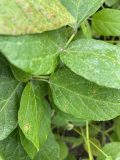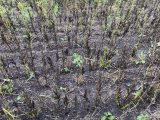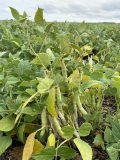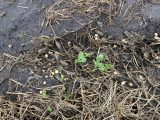 September 1, 2021
September 1, 2021
- Crop Update
- Soybean Harvest Tips
- Reducing Soybean Harvest Losses
- Dry Bean Harvest Tips
- Fall Rye Ahead of Next Year’s Dry Beans
- Pea Leaf Weevil in Manitoba
- Feeding Soybeans to Cattle
- Canadian Grain Commission Grading and Harvest Sample Program
- On-Farm Network Update: Late-Season Measurements and Harvest Preparations
- Soybean Maturity Guide
- Pre-Harvest Glyphosate Staging Guide for Faba Beans
Listen to The Bean Report:
Crop Update
- Soybeans range from range from R6.5 (beginning maturity) to R7 (physiological maturity; at least one brown pod on the main stem) across the province with some fields approaching R8 (full maturity).
- Patchy maturation has been noted in some fields with variability in moisture. Rains in the last few weeks will have helped fill pods prior to maturation.
- Soybean maturity ratings are underway at the regional variety trial locations.
- Past R7 (physiological maturity), soybeans are considered safe from fall frost damage.
- Dry beans range from R8 (beginning maturity) to R9 (full maturity).
- Field pea harvest is wrapped up in most areas. Faba bean harvest is beginning as crops have reached R8 (full maturity). Some fields are still at R7 (mid-maturity) where lower pods have ripened.
- Walk harvested pea and faba fields and check regrowth or sprouted harvest loss areas and check for signs of the pea leaf weevil – notching on the leaf edges. This is a new pest to Manitoba and we’ve now found it as far south east as Holland and Glenboro. Scouting for adult weevils in the fall before they overwinter can help inform management decisions next spring in nearby pea and faba crops. Read more on this topic below.
Soybean Harvest Tips
- Soybeans are ready for harvest once seed moisture is <14%, around 5-10 days after R8 (full maturity) has been reached. At R8, 95% of pods are brown, all leaves have dropped and seeds rattle within pods.
- Soybeans can be combined when seed moisture is below 20%, but seed must be stored at <14%. Avoid harvesting at <12% seed moisture to prevent cracking and splitting.
- Soybeans may be direct harvested (straight cut) or swathed. Direct harvesting is the preferred method. If swathed, combine shortly after to avoid quality loss. Soybeans are easily damaged by rain if left in the swath.
- Keep harvest speed below 5 mph to minimize header losses. Measure losses regularly during harvest to optimize your combine settings.
- If soybean seed moisture is <11%, harvest when humidity is high to reduce shatter loss and mechanical damage.
Reducing Soybean Harvest Losses
Since over 80% of harvest losses occur at the header, it is the focus for capturing yield at harvest time. The Bean App has a tool for calculating harvest yield losses based on lost soybean seed counts – this tool may be used to measure losses at the header or behind the combine.
Tips for reducing header losses:
- Type of header – A draper header, when properly adjusted (i.e., to the bean setting), can reduce yield loss by 0.5-1 bu/ac compared to an auger header.
- Angle setting of the header – Spend the time adjusting the header angle settings between crops to minimize losses, regardless of the header type. Getting the knife positioned between the ground and lower tip of the bottom pod is key.
- Use of an air system – Losses can be reduced by 0.5-1 bu/ac, on average, when using an air system on either a draper or auger header. At a price of $10/bu, this can provide a savings of $5-10/ac. To determine if an air system is worth the investment, consider that the payback area for an air system with an average capital cost of $16,500 would be 1,650-3,300 acres. This indicates that using an air system can provide substantial benefit in reducing losses.
- Ground speed – The effect of ground speed needs to be weighed against the urgency of harvest. Combine speeds of 3-4 mph reduce losses compared to higher speeds of 5-7 mph (average difference of 0.5 bu/ac).
Dry Bean Harvest Tips
Dry beans can be harvested by undercutting and windrowing, swathing or straight combining. Undercutting is typical for row-cropped beans and vine-type varieties that pod low to the ground. Straight combining or swathing is more common for solid-seeded beans and bush-type varieties with higher pods. Straight combining also requires flat soil that has not been inter-row cultivated.
Dry beans are ready for harvest when:
- All leaves have dropped
- All pods have changed colour
- 75% of pods are dry and the remaining pods may be flexible and yellow with seeds that have fully changed colour (R9 stage)
- Seed moisture is 16-18%
Tips for maintaining seed quality:
Soil intake and smearing
- To reduce soil intake, 1) place screen kits at the header and under the feeder house, 2) windrow beans that have been undercut to remove soil that is clinging to the roots and/or 3) increase fan speed if the soil is dry.
- Soft, puffy immature beans will dry down normally in the bin, but they need to be free of earth tag so that they are not smeared with soil and counted later as damaged seed. Waiting for these puffy beans to dry down naturally can result in a drier than desired sample, so following the above tactics to keep soil from entering the hopper and using a conveyor mounted on the combine to unload can help reduce smearing.
Splits and cracks
- To minimize splits and cracks (checking the sample periodically and aiming for <10%), 1) reduce cylinder speed by 100 rpm intervals until you see a noticeable difference, 2) close the concave if cylinder speed adjustments don’t make a difference, 3) use a bean (or wide wire) concave that allows beans to flow through the concave faster, 4) create larger windrows or straight-combine a wider width to keep more material flowing into the combine, which helps cushion the beans, and 5) harvest when plants are dry, so pods open more easily.
- Dry beans are often stored and traded at 17% seed moisture, but 16% is considered dry. If seeds are dried to less than 16% moisture, there is a greater risk of split seed coats and cracked or shriveled beans. If seed moisture rises above 18%, there is an increased risk of heating and spoilage.
Adapted from the Pulse Beat article Harvesting Tips to Improve Dry Bean Quality.
Fall Rye Ahead of Next Year’s Dry Beans
- Properly managed, fall rye as a cover crop ahead of edible beans can protect soil from erosion and minimize weed pressure while maintaining dry bean yield potential.
- Dry beans are planted late in spring, resulting in a long window of bare soil from the time when snow melts in the spring to when the crop goes in the ground.
- Rye termination must be carefully timed in the spring to maintain bean yield potential during plant establishment under dry conditions.
- Under relatively dry conditions from 2018 to 2020 at Carrington, ND pinto bean yields following a fall rye cover crop were statistically similar to the check when the rye was terminated with glyphosate 17-36 days before planting (Figure 1).
- Find the quick summary of Dr. Greg Endres, NDSU’s research on fall rye preceding soybeans and dry beans. Or, read the more detailed summary of managing rye as a cover crop.
- Research is ongoing at the University of Manitoba testing fall rye ahead of soybeans and dry beans in MB.
Pea Leaf Weevil in Manitoba

Pea leaf weevils (PLW) have been found in more areas of western and central Manitoba this fall. With recent establishment of this pest, population levels have been low for the most part meaning management practices like seed treatments would not yet be economical. Under dry conditions it is expected that PLW populations will remain low. However, some fields have had cooler temperatures and adequate moisture in the spring and early summer for good larval development. One such field of faba beans had sweep net counts averaging 10 weevils per 10 sweeps this August.
Scouting in the fall for PLW adults before they move to their overwintering areas (perennial legumes) is one method to determine if a seed treatment may be economical next year. Note that while estimates of population densities this fall/late summer could indicate risk for next spring, there has been limited research to confirm this and little information on what affects PLW overwintering ability. In the spring adult weevils disperse by flight, so they may travel a few kilometers to find host fields in the area.
Seed treatments remain the most effective chemical control option, though they do not provide complete protection. In research from Alberta, thiamethoxam seed treatments reduced PLW damage to nodules and leaves but only killed 30% of adult weevils and only about half of the larvae. The benefit from seed treatments appears to be from delayed egg-laying, fewer eggs laid and halving the number of larvae feeding.
There are insecticides registered for PLW control once thresholds have been reached (Peas: At VE to V6, 30% of plants have feeding notches on the uppermost, closed stipule (clam leaves). Fabas: At V2-V3, 15% of plants with notching on the uppermost closed bifoliate leaf). However, foliar sprays are not very effective since adult PLW will lay eggs as soon as they begin feeding on their host crops and since PLW will migrate into the field post-spray due to the long window of weevil emergence in the spring.
Feeding Soybeans to Cattle
If you are facing a feed shortage or if your soybean crop has been damaged, it is possible to harvest soybeans as silage or hay. It is a high protein, low fibre feed source. However, soybeans generally have a lower feed yield potential, and you must ensure that all applied herbicides are cleared for feed use, or that the appropriate interval between application and harvest has passed.
Silage
Harvesting soybeans for silage is the preferred feed method. The optimum time to harvest is just before the R7 stage when seeds fill the pods completely and the lower leaves are just beginning to turn yellow. If harvested later than this, the oil content will be higher and it is recommended to mix in grass. Mixing in grass is also generally recommended to improve palatability. Harvest using a mower-conditioner (i.e., Haybine). Dry silage to 65-70% moisture if storing in a silo tube or bunker silo, or to 60-65% moisture if storing in an upright silo.
Hay
If you are considering turning soybeans into hay, know that it is not the preferred method. Soybean hay has a longer drying time, leaf loss will be greater than if you are ensiling and it is often dusty with brittle stems. The optimum time to harvest is earlier than if harvesting for silage.
Adapted from Soybeans for Hay or Silage – University of Wisconsin-Extension. Additional information is available from Manitoba Agriculture and Resource Development on feeds and nutrition, and managing livestock under drought conditions.
On-Farm Network Update
Late-Season Measurements & Harvest Prep
The OFN team has been busy with late season measurements. Late season plant counts are a focus at this time of year, assessing changes in plant population over time in seeding rate and row spacing trials. We are looking to characterize the effect of plant-to-plant competition on plant population over the course of the growing season. We are also continuing to visually track residue decomposition and plant vigour differences in our dry bean tillage trials. We’re seeing some quite spectacular visual differences between strip-till and conventional till beans this season.
Soil sampling to track nitrate concentration and changes over the growing season is ongoing. This was added on at 15 different OFN trials this year, in response to unusually and unexpectedly high residual nitrate in these fields this spring. Through regular in-season sampling, we are hoping to identify possible mechanisms causing the flush of nitrate, and investigate trends in fluctuating nitrate concentrations over the season.
As crops turn and the combines roll, we look forward to completing data collection and compiling results from our 2021 trials!
Canadian Grain Commissions’ Harvest Sample Program
You can sign up to receive a harvest sample kit to submit your crop to the CGC for an assessment of your grain’s quality at no cost. Results can be used when marketing and delivering your grain. Mail your samples following harvest. The CGC accepts samples until November 30 and results are available within 20 days.
Quality results include:
- Unofficial grade
- Protein content on barley, beans, chickpeas, lentils, oats, peas and wheat
- Dockage assessment on canola
- Oil, protein and chlorophyll content for canola
- Oil and protein content and iodine value for flaxseed
- Oil and protein for mustard seed and soybeans
- Falling number for wheat and rye
- Vomitoxin (deoxynivalenol or DON) levels for wheat, corn and barley



























